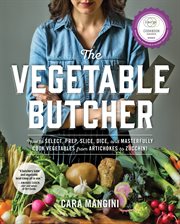Nonfiction
eBook
Details
PUBLISHED
Made available through hoopla
DESCRIPTION
1 online resource
ISBN/ISSN
LANGUAGE
NOTES
A root-to-leaf guide to vegetable butchery, with 150 recipes. Winner, IACP Cookbook Awards for Single Subject and People's Choice. Applying the skills of butchery to the unique anatomy of vegetables-leafy, lumpy, stalky, gnarly, thin-skinned, or softly yielding-Cara Mangini shows, slice by slice, how to break down more than 100 vegetables for their very best use in the kitchen. Here's how to peel a tomato, butcher a butternut squash, cut cauliflower steaks, and chiffonade kale. How to find the tender, meaty heart of an artichoke and transform satellite-shaped kohlrabi into paper-thin rounds, to be served as a refreshing carpaccio. And then, more than 150 recipes that will forever change the dutiful notion of "eat your veggies"-Grilled Asparagus, Taleggio, and Fried Egg Panini in the spring; summery Zucchini, Sweet Corn, and Basil Penne with Pine Nuts and Mozzarella; and Parsnip-Ginger Layer Cake with Browned Buttercream Frosting to sweeten a winter meal. Plus everything else you need to know to enjoy modern, sexy, and extraordinarily delicious vegetables-and make the the center of the meal. Winner, IACP Cookbook Awards for Single Subject and People's Choice. The craft of butchery meets the pleasure of garden-fresh vegetables in this A-to-Z veggie primer packed with how-to prep info (with step-by-step photos) and more than 150 modern, exciting recipes featuring vegetables at the center of the plate. Cara Mangini was Eataly's first official Vegetable Butcher; she is now the executive chef and owner of littleEATERY and littleEATER salads in Columbus, OH, and writes the "Vegetable Butcher" column for TheKitchn.com. Cara has a culinary arts degree from the National Gourmet Institute in New York City, and has partnered with acclaimed chefs and cookbook authors, working at the James Beard House and as a sous chef at New York's Culinary Loft. Before her pursuits in food, Cara attended the Medill School of Journalism at Northwestern University, and wrote about fashion for the Chicago Tribune and travel for Conde Nast Traveler. She spent nearly 10 years as an executive in the New York beauty and fashion industry. Eggplant It is difficult to imagine that eggplant was once thought to be poisonous, feared for its bitterness, and overlooked for the beauty of its flowers. Now eggplants are almost impossible to resist-available in all shapes, colors, and sizes-with a flesh that becomes silky when cooked. Best seasons: Mid-summer to early fall Good partners: Arugula, balsamic vinegar, basil, cilantro, coconut milk, cornmeal, cream, dill, farro, feta, garlic, ginger, goat cheese, green beans, honey, mascarpone, mint, mizuna, mozzarella, onion, orange, parmesan, parsley, peppers, pine nuts, polenta, provolone, red pepper flakes, red wine vinegar, ricotta, ricotta salata, sesame seeds, tahini, toasted sesame oil, yogurt, za'atar Varieties to try: Globe/Purple/Western (the classic, all-purpose eggplant). Japanese and Chinese (long and slender). Italian. Fairy Tale, Rosa Bianca, Listada di Gandia (three small heirloom varieties). White (snowy white). Selection: Look for an eggplant that is very shiny and heavy for its size and gives slightly to the touch: It should be neither rock-hard nor squishy. Avoid eggplants with puckered skin or soft spots that indicate bruising. Eggplant comes in many shapes and sizes, but as a general rule, younger (smaller) eggplants are sweeter, have fewer to almost no seeds, and thinner skin. I generally recommend small to medium eggplant, but larger ones are fine for grilling steaks or roasting and turning into a puree. Storage: Use eggplants within a few days of purchase to avoid their potential bitterness. Storing them requires a balancing act. If they become too cool for too long, their seeds will harden and their flesh will become bitter, but leaving them in the heat for too long
Mode of access: World Wide Web







